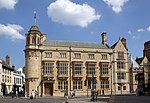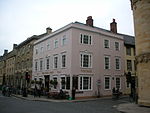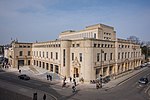Oxford Martin School
2005 establishments in EnglandDepartments of the University of OxfordEducational institutions established in 2005Multidisciplinary research institutesResearch institutes in Oxford
The Oxford Martin School is a research and policy unit based in the Social Sciences Division of the University of Oxford. It was founded in June 2005 as the James Martin 21st Century School and is located in the original building of the Indian Institute. It is named after its benefactor, James Martin, author of the books The Wired Society and The Meaning of the 21st Century. Its Director is Charles Godfray, who took up the post in February 2018.'Finding solutions to the world's most urgent problems' is the stated mission of the Oxford Martin School.
Excerpt from the Wikipedia article Oxford Martin School (License: CC BY-SA 3.0, Authors).Oxford Martin School
Broad Street, Oxford City Centre
Geographical coordinates (GPS) Address Website External links Nearby Places Show on map
Geographical coordinates (GPS)
| Latitude | Longitude |
|---|---|
| N 51.7549 ° | E -1.2542 ° |
Address
Oxford Martin School (Old Indian Institute)
Broad Street 34
OX1 3BD Oxford, City Centre
England, United Kingdom
Open on Google Maps









